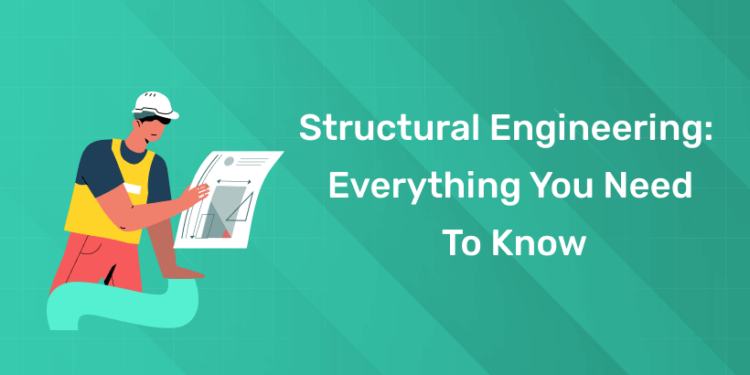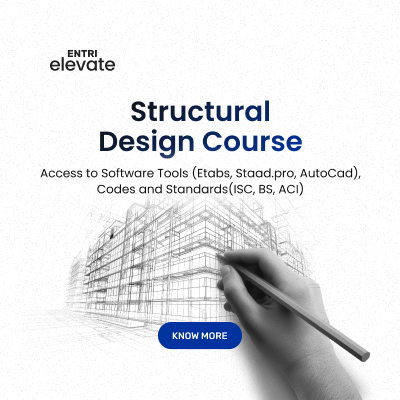Table of Contents
Structural engineering is a key part of civil engineering and is all about designing and calculating buildings, bridges and things. Safety, stability and being able to resist forces and loads is what it’s all about. In this article we’ll cover what structural engineering is, the jobs in structural engineering, the pros of being a structural engineer and how you can upskill with Entri’s structural design course.
What is Structural Engineering?
Structural engineering is a part of civil engineering that’s about designing, building and maintaining things. These things have to bear loads and resist environmental forces while looking and being intact. They work on:
- Buildings (residential, commercial, industrial)
- Bridges and tunnels
- Dams and reservoirs
- Towers and masts
- Offshore structures
- Infrastructure (roads, railways)
Structural engineers use physics, maths and material science to calculate and design. It’s got to look good and work and be safe and last.
Build A Career In Structural Engineering! Get Free Demo Classes!!
Jobs in Structural Engineering
1: What is the primary purpose of structural design?
Structural engineering has lots of careers. Here are a few of them.
1. Design Engineer
Design engineers create the plans and specs for things. CAD software and blueprints and building codes and standards.
2. Construction Engineer
Construction engineers build things according to design. Manage sites, contract with others and solve problems.
Transform Your Career with Our Structural Design Course!
Unlock Your Potential in Structural Design! Gain expert knowledge in designing robust structures and advance your career in the construction and engineering fields. Limited spots available! 🌟
Know MoreTypes of Structural Engineering Jobs
It has many career options. Here are a few of those.
1. Design Engineer
Design engineers plan and spec. CAD, blueprints, building codes and standards.
2. Construction Engineer
Build according to design. Site manage, contract, solve.
3. Project Manager
Project managers plan, execute and close projects. Budget, schedule and resource allocation. Projects on time and within budget.
4. Structural Analyst
Structural analysts are about existing buildings and infrastructure. Advanced software to simulate loads and stresses and find weaknesses and repair or reinforce.
5. Forensic Engineer
Forensic engineers are into structural failures and accidents. Evidence analysis and legal testimony.
6. R&D Engineer
R&D are into developing new materials, technologies and methods. Experiments, data analysis and all that good stuff are done by them and you need patience .
7. Teaching and Academia
Academics teach, research and write papers. Future engineers to educate and train.
Benefits of being a Structural Engineer
Being a structural engineer has many benefits:
1. Job Security
As infrastructure grows the demand for structural engineers will always be there. This job can provide plenty of variety to keep things from becoming stale as you constantly work on new projects.
2. Good Salary
Structural engineers are well paid for their skills. According to industry stats the average salary for structural engineers is good and has room for growth.
3. Many Career Options
Structural engineering has many career paths. Whether you like design, construction, research or project management there are many options to choose from.
4. Meaningful Work
Structural engineers shape the built environment. Their work makes structures safe, functional and resilient. This has a real impact on communities and society.
5. Lifelong Learning
Structural engineering is a constantly evolving field with new technologies and methods emerging all the time. This means there is always opportunity for lifelong learning.
Build A Career In Structural Engineering! Get Free Demo Classes!!
Entri’s Structural Design Course
To be a good structural engineer you need to have a solid foundation in the principles and practices of the field. The Structural Design Course by Entri Elevate is tailored for civil engineers seeking to advance their careers and secure high-paying office jobs in India and abroad. It equips students with the necessary skills and knowledge to thrive in this dynamic field. The program offers comprehensive training and hands-on experience, preparing students for success in structural engineering.
Why Entri’s Structural Design Course?
- Expert Trainers: Learn from structural engineers and industry experts.
- Practical: Get hands on experience through real world projects and simulations.
- Flexible: Access course materials online and study at your own pace.
- Certification: Get a recognized certificate upon completion and boost your CV.
For more information about Entri Structural Design Course visit Entri Structural Design Course.
Transform Your Career with Our Structural Design Course!
Unlock Your Potential in Structural Design! Gain expert knowledge in designing robust structures and advance your career in the construction and engineering fields. Limited spots available! 🌟
Know MoreConclusion
Structural engineering is a fun and rewarding field with many career options. Whether you like design, construction, research or project management there are many ways to go. With a solid foundation in structural engineering principles and the right skills you can make a big impact on the built environment.
Entri’s Structural Design Course gives you the knowledge and practical experience to excel in this field. Join this course and enhance your skills, boost your career and create safe, functional and resilient structures. Don’t miss out on your chance to advance your structural engineering career – join Entri’s course today and start your journey to success.
|
Engineering Upskilling Courses
|
| MEP Course |
| BIM Course |
| Quantity Surveyor Course |
| Structural Design Course |
| MEP QS Course |
Transform Your Career with Our Structural Design Course!
Unlock Your Potential in Structural Design! Gain expert knowledge in designing robust structures and advance your career in the construction and engineering fields. Limited spots available! 🌟
Know MoreFrequently Asked Questions
What are the qualifications to be a structural engineer?
To be a structural engineer you usually need a civil engineering degree or equivalent. And then certifications and licenses like PE license depending on the country and job.
What software’s are used in structural engineering?
AutoCAD, SAP2000, ETABS, STAAD.Pro, Revit are the most common software’s used for designing, analyzing and visualizing.
What does a structural engineer do in construction?
Structural engineer designs and analyzes the structural parts of the project and the loads and forces on it. He/she works with architects, contractors and other engineers to make sure the structure is safe and sound.
How structural engineering helps in sustainability?
Structural engineer helps in sustainability by designing energy efficient buildings, green materials and renewable energy. Waste reduction and environmental footprint of the project.
What are the problems structural engineers face?
Complex design requirements, building codes and regulations, safety and technology and material changes are the key problems for structural engineers.














